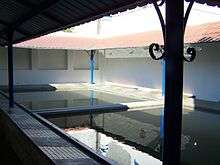Lavoir

A lavoir (wash-house) is a public place set aside for the washing of clothes. Communal washing places were common in Europe until industrial washing was introduced, and they in turn were replaced by launderettes. The English word is borrowed from the French language.
Lavoirs are commonly sited on a spring or beside or set over a river. Many lavoirs are provided with roofs for shelter. With the coming of piped water supplies and modern drainage, lavoirs have been steadily falling into disuse although a number of communities have restored ancient lavoirs, some of which date back to the 10th century.
There are also bateaux-lavoirs (lavoir boats) in some towns on the banks of large rivers such as Paris and Lyon.
The lavoir in Rives (74 200 Thonon, Haute-Savoie, France) is lit in by the March afternoon slanting sun. Polished stone slabs line around the central pool, which reflects its light against the wall (note the date 1887 on a plaque), and the hall is cool and quiet, while it was a century ago ringing with bat thuds, washing songs and the loud chatter of gossips.
Gallery
 A lavoir at Groix
A lavoir at Groix Lavoir at Noyers
Lavoir at Noyers Lavoir at Gunstett
Lavoir at Gunstett Bateaux-lavoirs at Laval
Bateaux-lavoirs at Laval_lavadero_p%C3%BAblico_(RPS_27-09-2014).png)

 Public washbasins at San Miguel de Allende (México)
Public washbasins at San Miguel de Allende (México)
References
External links
| Wikimedia Commons has media related to Wash houses in France by department. |
- (French) Lavoirs of France
- (French) Les lavoirs de France
- (French) Lavoirs in the department Aube
- (French) Lavoirs in Champagne-Ardenne
- (French) Lavoirs in Burgundy and Franche-comté